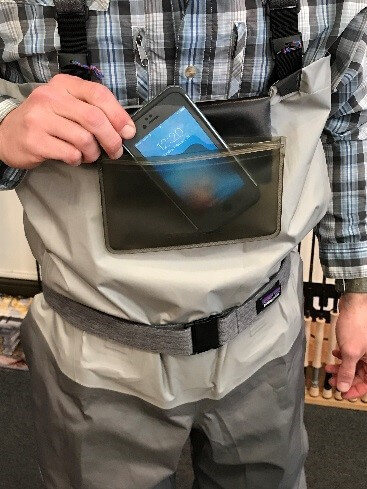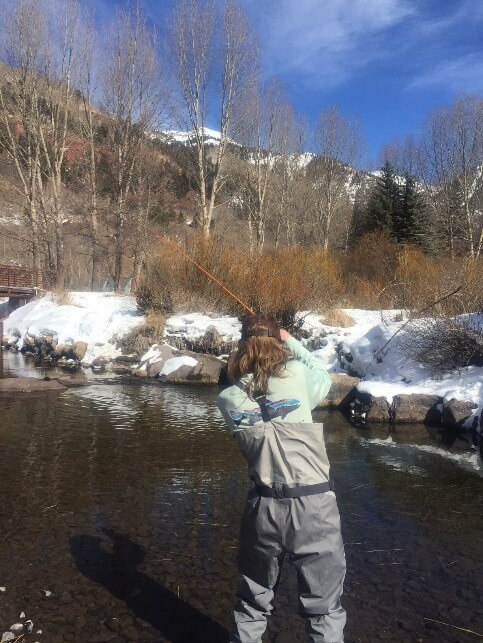by Richard Post, Telluride Angler
Patagonia has changed the wader game with the Middle Fork Packable Wader. After testing them in the Gunnison, I was sold on their clever utility made possible by innovative design with appropriate features for a true packable wader.
 Sneak Preview
Sneak Preview
I’m at a Patagonia dealer event on the Gunnison River (May, 2017). My buddy Dave, the Patagonia rep, tosses me a stuff sack and says, “Hey man, would you put these on for me, they’re your size, and we’ll get this show on the road.” I reply, “Sure man, but what is this? Did y’all come out with a new rain jacket or something?” Dave replies, “They’re waders, Rich.”
The stuff sack I had in my hands was about a foot long, maybe six inches around and weighed about a pound. I figured it to be the size and weight of a fishing-specific rain jacket in a stuff sack. Lo and behold, when I emptied the sack, a pair of full-sized chest waders appeared. That was Patagonia’s unofficial sneak peak of the coming Middle Fork Wader.
Field Test in the Gunnison Gorge

Middle Fork Wader Design Concept and Material

The fabric is also completely re-designed on these waders. The lower wader features a 4-layer fabric similar in weight to the Rio Azul and the River Salt Jacket, but with a more supple hand. Above the waist the waders utilize a 3-layer fabric very similar to the Torrentshell Rain Jacket (Torrentshell fabric is 2.5 layer H2No and the Middle Fork Packable Waders feature a 3-layer version). The upper is more breathable than any other wader upper, while still light, waterproof and submersible.
Additionally, Patagonia tweaked the design and materials of the wader body. They developed a proprietary seam tape that is lighter, stronger and more streamlined than traditional tape while advancing their single seam technology to require less seam taping in general. The main seam of the lower leg contours around the outside of the knee for an ergonomic and articulated fit. The other seam starts behind the knee and contours to the inner thigh where it meets with the seam from the gusseted crotch. The patterning of the seams on these is very intelligent and provides an exceptional fit.
Middle Fork Wader Features
The suspenders still mount at the waist, the same system as the Rio Gallegos II, allowing the fisherman to wear them as waist-high waders or to answer nature’s call while wearing a rain jacket. The straps, buckles and wading belt are all unique to this model and paired down to minimize weight while maintaining comfort and functionality. They also sport a heavy-duty scuff guard on the inside of the gravel guard. I believe this gravel guard is an improvement on the Rio Gallegos II and something I hope to see in the next generation of that wader.
Even though these waders are paired down to save weight, you don’t lose out on many of the features you’ve come to expect in a pair of Patagonia waders. In addition to the aforementioned waist-mounted suspenders which come with a neat loop of cord to make finding and flipping the buckle easy, the Middle Fork Wader also comes with a waterproof pocket attached to the inside at the top (similar to the Rio Gallegos II) sized specifically for a phone.
One belt loop at the rear keeps the wading belt in place and a Fitz Roy Trout logo is front and center on the wader. The color is a two-tone grey that they call Hex Grey. The lighter fabric on the upper body is lighter colored and the heavier fabric from the butt down is darker grey. The only thing I miss on these waders is a hand warmer pocket. I have a habit of putting an idle hand there while I’m swinging flies. Remember that these are a lightweight wader and can’t have everything, or else they would not be a lightweight wader. Overall, I believe these waders are a complete game-changer. They will fill a niche in my fly fishing kit that will lighten up my pack while maximizing the versatility of my gear.
Telluride Angler’s Parker Thompson putting Patagonia Middle Fork Waders to work on the San Miguel River in the town of Telluride.





